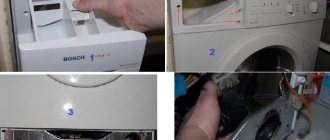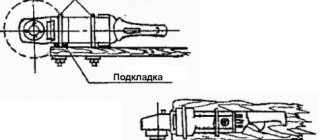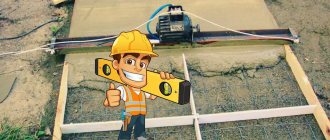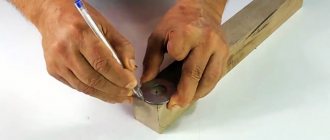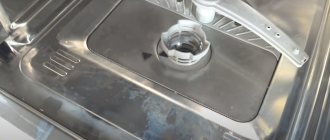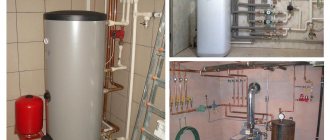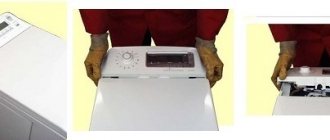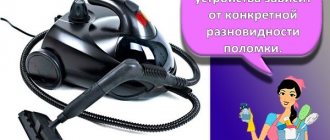We have already told you how to repair a boiler with your own hands, providing detailed instructions with video lessons. Today I would like to pay more attention to the procedure for disassembling and assembling a water heating tank for 10-80 liters, because... There are several design options that differ from each other. The relevance of the issue is that if you remove the heating element or electronic elements incorrectly, you can break them, which, of course, is undesirable. Next, we will tell you how to disassemble a water heater with various types of mounting heating elements from manufacturers such as Termex, Ariston, Gorenia, etc.
Reasons for disassembling the boiler
In what cases will you have to disassemble the equipment yourself? There may be several reasons. First, we will give signs by which you can recognize the problem:
- The water has an unpleasant odor and a cloudy color.
- Flakes of scale are noticeable.
- The body is electrocuted.
- The RCD often trips. Why a water heater knocks out an RCD, read in a separate article.
- The water takes a long time to heat up or does not heat up at all.
- The set is slow, the flow is weak.
- Housing leak.
These signs indicate problems with the boiler. What could have caused the problem:
- Late tank maintenance . If the region has hard water, magnesium and potassium salts settle on the walls of the housing and parts when heated. As a result, an unpleasant odor and turbidity appear. The water takes a long time to heat up because the thermal conductivity of the heating element decreases. Once every six months it is recommended to look into the tank and check its condition, replace the magnesium anode and clean the parts.
- Wear of gaskets . If the tank is leaking, the gaskets are inspected first. If the housing becomes corroded, replacement will be required.
- The heating element burned out . In such cases, you need to install a new element.
- Thermostat failure.
Common breakdowns and repair methods
Next, we will consider the most common problems with a water heater and provide repair methods for each of the breakdowns.
Problem #1 - heating element malfunction
Failure of the heating element is a typical problem for both instantaneous and storage water heaters. This element works under high load and therefore wears out quickly. If the power supply is connected, but the water in the tank does not heat up, most likely the problem has arisen with the heating element.
The heating element should be removed from the tank carefully, especially if a significant amount of scale has accumulated on its surface. Sudden movements can lead to deformation and breakage of some elements
First, you should check whether electricity is flowing to the heating element and thermostat. At the cable connection points, check the presence of voltage with a tester.
If there is no power, you may need to replace the cable itself or check to see if there is a power outage throughout the house.
Regardless of the model type, each thermostat has a power button. When you press it, the device turns on, and when you turn it off, the button returns to its original position.
If there is electricity and the cable is working properly, then problems have arisen with the heating element, which will have to be replaced, or with the thermostat. To figure out what exactly is broken, you need to remove the thermostat and check it with a tester.
Testing the serviceability of the heating element is carried out as follows. First, the measuring scale of the device is set to 220-250 V. Then the resistance is measured at the terminals connecting the heating element to the electrical network.
If there is voltage, you should disconnect the heating element from the network and check the potential at the terminals of the heating element. The lack of response from the tester will indicate that the device is faulty. If there is a reaction, you need to continue the diagnosis.
First, disconnect the water heater from the power supply. Then the heating element is disconnected from the thermostat so that the contacts of the heating element remain uninsulated.
The contacts of the tester are applied to them and the reaction is observed. If it is, the heating element is working, but if not, the heating element needs to be replaced. In this case, it does not matter what numbers the tester produces, only the presence or absence of a reaction is important.
These fault detection methods are suitable for both storage electric water heaters and instantaneous models.
To determine the serviceability of the heating element and thermal relay, an electrical tester is used. Typically, the presence of voltage on the contacts indicates the serviceability of the element, and its absence indicates the need for repair
Problem #2 - thermostat failure
To check the serviceability of the thermostat removed from the water heater, you need to set the adjustment knob to maximum and take measurements at the inlet and outlet of the device. If the tester's needle remains calm, i.e. its position does not change, which means the thermostat is faulty and needs to be replaced.
If the arrow deviates, then you need to continue testing. Now you should set the thermostat to the minimum position and apply the tester's measuring probes to the contacts. It will not be easy to continue the diagnosis alone; you will have to fix the probes or ask someone to hold them for some time in the correct position.
After this, you need to take a lighter and heat the tip of the temperature sensor. If the thermal relay works, the circuit opens, and the resistance on the tester scale goes down sharply, then the thermal relay can also be considered working. If the system does not respond to heating, then this element is damaged and needs to be completely replaced.
Sometimes a water heater may stop working due to the safety valve tripping, causing the unit to dangerously overheat. It is enough to correctly adjust the operation of the device so that it starts working as usual.
First you need to unfasten the fasteners of the heating elements and the thermostat (red arrows), then unscrew the screw (green arrow) and nuts (blue arrows. The thermostat is circled with a yellow line
Problem #3 - control board malfunction
If the check shows that both the heating element and the thermostat are working, most likely the problem has arisen with the control board. It is almost impossible to repair such an element at home.
You will have to replace it with a new one, and you will have to use the help of a specialist who will help you set up the electronic equipment. Most often, you just need to contact a service center, where the required element will be selected and installed correctly.
Typically, the heating element is secured with six bolts and nuts (marked with red indicators). When reassembling, it is recommended to tighten them evenly
Problem #4 - tank leaking
A tank leak is a serious problem that you cannot always fix on your own. In some models, either the tank or the entire heater will have to be replaced.
Sometimes the leak can be sealed, but care must be taken to restore the integrity of the outer casing and the thermal insulation layer. Usually such measures are insufficient and short-lived, and soon the leak will occur again.
If water leaks from places marked with black indicators, it is likely that the gasket or heating element needs to be replaced; red indicators mark places of leaks if the internal tank is damaged
A water heater tank is most likely to leak if:
- damage to the internal tank has occurred;
- the heating element has deteriorated;
- the gasket has leaked.
If water flows at the place where the heating element is attached, it may not be necessary to repair the tank itself. A special gasket is installed in this place; a leak may be caused by its damage. The gasket is replaced and this solves the problem.
A leaking water heater tank is usually caused by neglect or late maintenance, which also includes replacing the magnesium anode. Another common problem is lack of grounding. This can also lead to the development of corrosion processes and leakage.
If it is necessary to replace the gasket, you should select a new one of exactly the same size and shape and made of suitable materials
If you need to replace a gasket or heating element, it is best to first dismantle the faulty element in order to take it with you and select an exact analogue. Purchasing parts by eye can lead to unnecessary expenses. Making such a replacement is relatively easy.
But if problems arise with the tank, you will have to at least contact a service center. You must immediately find documents for the water heater and clarify the warranty periods and service conditions.
Before repairing or cleaning the water heater, you must remove the protective cover, which can be located at the bottom, center or side
How does a boiler work?
There are storage and instantaneous water heaters. The first ones consist of a large container in which a heating element is installed. Water enters the device and is stored there at a certain temperature.
Using a temperature sensor connected to a thermostat , the temperature is maintained at the set level. To prevent loss of thermal energy, the body of the storage tank is covered with a layer of insulation.
Before starting to operate the boiler, you should study its structure, technical characteristics and manufacturer’s operating recommendations in order to prevent breakdowns
Flow models work differently. They also have a housing and a heating element, but do not store water inside. The device turns on the moment water flows through its body. The liquid quickly heats up to the desired temperature. These devices are more powerful than storage models; they consume more electricity. But their sizes are compact and installation is a little easier.
And yet, in everyday life, a storage version of the water heater is more often used. Failures of different types of devices are similar, and they are eliminated using approximately the same means.
To automate the operation of the water heater, use a thermostat . This element receives data about the current state using a temperature sensor. It turns the heating element on and off based on incoming information. This helps not only maintain the optimal temperature inside the drive, but also makes it possible to save energy.
The device also prevents dangerous overheating of water, which could cause a serious accident.
If the boiler is leaking in the area where the water pipes are connected, incorrect installation of the device is most likely to blame, and the connections will need to be resealed
Hot water is gradually withdrawn from the tank and replaced by cold streams from the water supply. At this moment the heating element usually turns on. If the hot water in the boiler has not been used for a long time, it may cool down. Too low a temperature also gives a signal to turn on the heating element.
Types of heaters according to the heating element used
There are boilers with “dry” and “wet” heating elements. In the first version, the heating element is placed in a special flask, and in the second it is in direct contact with water. Both models have certain advantages. In terms of boiler repair, it is believed that it is much easier to replace a “dry” heating element than a “wet” one, since to do this you just need to remove it from the flask and put a new element there.
In the case of a “wet” heating element, you will first have to completely drain the water from the container, and only then replace it. Typically, “dry” heating elements are less efficient than the “wet” version, so not one, but two such heating elements are most often installed in a boiler.
A “dry” heating element is not the same, but replacing it is somewhat easier, since you do not need to drain the water from the tank
Due to the nature of their operation, “dry” heating elements burn out more often and need to be replaced, therefore models with “wet” heating elements are more popular. It is worth noting that you can also find modern boilers with very reliable “dry” heating elements of the latest generation, but the cost of such devices may be too high.
But the type of heating element does not affect the amount of scale formed during operation. But if with a “wet” element scale deposits directly on the surface, then with a “dry” heating element the deposits accumulate on the protective flask.
How to remove lime deposits?
The removed heating element is cleaned in two ways: mechanical and chemical. If the lime deposits are thick, then both methods are used together.
First, large deposits are removed from the tubular part using physical force, and then the remaining limescale marks are removed chemically.
To do this, fill a cylindrical container (for example, an enamel bucket) with cleaning liquid and lower the heating element into it. The exposure time depends on the nature of the reagent.
The boiler tank itself also needs to be cleaned after removing the heating element. The procedure is carried out using a hose - it is inserted into the tank. Turn on the water under pressure and wash away the dirt.
How to remove using folk remedies?
To dissolve the solid salt deposit on the heating element, it is necessary to use substances with an acidic reaction. Used as home cleaners:
- Lemon acid. Pour two 25 gram packets of powder into a liter of water. When all the crystals have dissolved, a heating element is lowered into the solution. Leave for a day, after which the heating element is washed in clean water.
- Acetic acid. If a vinegar solution of medium concentration (9%) is used for cleaning, then take 5 tablespoons per liter of water. If only essence is available, then its quantity should be 2 tablespoons for the same volume of water. The holding time is 10-12 hours.
- Mechanical cleaning. To remove limestone, use a metal brush, scraper, or sandpaper. The method is labor-intensive and cannot be used to clean the anode.
If there is too much scale, then the amount of reagent can be increased, and the metal container with the solution and heating element can be placed on low heat and heated for 30-60 minutes.
How to remove plaque with household chemicals?
Ready-made liquids sold in household chemical stores are distinguished by a special composition that guarantees the effectiveness of cleansing. Various companies produce such products:
- Boiler-Cleaner. Acid remedy. The liquid is used against carbonate salts and iron oxide. The composition includes a complex of acids, an anti-corrosion additive and substances that enhance the effect of the main reagents. To clean a contaminated surface, the liquid is mixed with water to obtain a concentration of 5 to 12%. The heating element is lowered into the solution and kept for 8 hours. The cost of a 5-liter canister is on average 480 rubles.
- SteelTEX. The formula of the product includes surfactants and corrosion inhibitor additives. The liquid helps remove metal oxides, salts, rust, and biological inclusions from the heating element. According to the instructions for use, SteelTEX is diluted with water in a ratio of 1:6 to 1:10. The stronger the contamination, the stronger the solution should be. After washing, use an alkaline neutralizer. The price of the product (20 kg) is about 4,200 rubles.
- Cillit ZN/I. This reagent from a German manufacturer is designed to combat rust and lime salts. To treat heating elements, prepare a solution of 1 part of the product and 9 parts of water. The part is kept in the solution for 1-4 hours at a temperature of 20 to 40 degrees. If necessary, heating is allowed. The average cost of a 20 kg canister is 10,700 rubles.
In what cases is it necessary to disassemble the boiler?
Gas boiler wiring diagram.
The magnesium anode in the boiler, used as a catalyst to protect against corrosion of the tank walls and aggressive effects on the heating device, must be changed periodically.
We recommend: Heating system with forced circulation: single-pipe, two-pipe scheme for one-story and two-story houses
The service life of the anode depends on the quality of the water used in the boiler (it is recommended to install a special filter on the cold water supply pipe), the operating temperature of the water, and the intensity of operation of the water heater.
The standard period of use of a magnesium anode, indicated in the boiler operating instructions, does not exceed 6 months. When using the boiler in a gentle mode, the magnesium anode can last 1-1.5 years without replacement.
Along with replacing the anode, as a preventative measure for the water heater, it is necessary to thoroughly clean the inside of the tank from scale and wash the walls.
The heating element must also be cleaned using special chemicals or a regular metal dish sponge.
An additional need to disassemble the water heater arises as a result of an accident, breakdown or reaction of the boiler to non-standard operating conditions.
As a rule, the heating element fails.
Diagram of connecting the boiler to the network.
If the water from the boiler has an unpleasant odor, yellow or brownish tint, this indicates corrosion and clogging of the tank. The same is evidenced by the fact that the water takes too long to heat up and the appearance of loud extraneous sounds during operation of the heating element.
It is necessary to immediately disassemble the boiler, determine the malfunction and eliminate it. In any case, you should thoroughly rinse the boiler and make sure that both the walls of the storage tank and the heating element are clean.
If there is a leak in the boiler, you need to make sure that the rubber waterproofing gasket is reliable. If necessary, the gasket should be changed.
If the leak occurred as a result of depressurization of the storage tank itself, it is not possible to repair such a breakdown with your own hands. This may be a manufacturing defect - then the boiler must be replaced in accordance with the warranty agreements.
Sometimes, as a result of improper operation of the boiler, the walls of the storage tank may rust. In this case, the procedure for replacing the storage tank may cost more than a new water heater.
Do-it-yourself troubleshooting
Heating of the cold water supply pipe can only occur for two reasons:
- The safety valve is faulty.
- The valve is not installed in its original place.
The repair boils down to replacing the faulty valve or simply installing it at the junction of the cold water pipe and the boiler pipe. Installation of a safety valve, if included, is required by the manufacturer. Failure to install it will result in denial of warranty repairs. The absence of a valve can lead to tank rupture due to water hammer.
A water heater tank leaks when the connection between the flange and the body is leaking or when the tank wears out. If the internal tank is damaged, it is impossible to repair the water heater yourself and you will have to replace it, if the boiler model allows it. Or you will have to buy a new water heater.
If it is determined that the flange gasket is leaking, drain the tank as indicated above, remove the flange, and visually assess the condition of the gasket. Buy a new one, using the faulty one as a sample. Replace the gasket and continue using the boiler.
Heating of the plug can occur due to loosening of the contacts in the socket and insufficient contact between it and the plug. With prolonged use and constant overheating of the contacts, the housing may melt, which will lead to a short circuit.
Heating of the plug can also occur if the power of the outlet and electrical wiring in the apartment is insufficient. The socket body must be marked 10A.
If the plug body melts, cut it off and replace it with a new one.
The boiler gives an electric shock, the machine turns off or it does not heat the water - this indicates a failure of the heating element. If, when disassembling the boiler, it is discovered that the heater is black and has burst lengthwise, this will unmistakably indicate its failure.
If the heating element does not have obvious signs of failure, you can diagnose the malfunction using a multimeter.
- Step 1: Wet the heater tubes with water. Set the multimeter pointer on the ohmmeter scale to the maximum value and measure the resistance, touching the heating element tube with one probe of the device, and any of its contacts with the other. If numbers appear on the display, the heater is faulty and needs to be replaced. “1” indicates no leakage “to the body”
- Step 2. Touch the contacts of the heating element with the probes. If the numbers appear, there is no break in the spiral, it is working properly. “1” on the display in this case indicates a rupture of the spiral and a malfunction of the element.
These are the main boiler malfunctions when DIY repairs are possible.
Features of various designs
Before you start repairing a water heater with your own hands, you need to figure out what type of device it is. There are several varieties:
- electric boilers;
- flow-through;
- indirect heating systems;
- geysers.
The word "boiler" means "boiler". It follows from this that such products include not only storage devices, but also flow-through devices.
Electric heaters
This type of boiler is considered the most popular. The design consists of a tank, a thermal insulation layer (polyurethane foam is often used), and an upper casing.
The heating element is located at the bottom of the device. The water is heated to a certain temperature, which is pre-set on the thermostat, the maximum value is +75°C.
If no water is drawn, the device maintains temperature readings by turning the heating element on and off. It is equipped with overheating protection, so when the maximum performance is reached, the device turns off.
The optimal temperature value is +55°C; it is in this operating mode that the structure will last longer and save electricity.
This device is the most common
Hot water is drawn through a tube located at the top of the device. The cold liquid inlet is located at the bottom of the device. The metal tank is protected from corrosion by a special magnesium anode, which has a certain working life. The element must be replaced once or twice a year, depending on the hardness of the water.
Indirect heating systems
Such products do not independently generate thermal energy; water is heated using a coil in which the coolant is located.
Cold water comes from the bottom of the device, hot water comes out from the top. Indirect heating devices can provide large quantities of hot water, which is why they are often installed in large houses. The operating principle is to exchange heat between liquids at different temperatures. In order for the output to be +55°C, heating is carried out to +80°C.
The process takes a lot of time, this feature must be taken into account when choosing a suitable device. Like their electrical counterparts, indirect ones are equipped with a magnesium anode. The structures can be wall-mounted or floor-mounted; in addition, they can be connected to a double-circuit gas boiler. More expensive models are equipped with additional electric heating elements, which reduce heating time as needed.
Gas and flow structures
Gas-powered appliances are only wall-mounted. There is a thermal insulation layer inside the structure. There is a chimney pipe at the top, and a gas burner at the bottom. The latter is a source of heating, in addition, it is helped by the heat circulation of combustion products. An automatic electronic system monitors and extinguishes the gas as needed. The column is equipped with a protective anode.
Gas water heaters produce large amounts of hot water in a short period of time.
Flow systems do not accumulate liquid inside. The heating process occurs at the moment the tap is opened, when the devices allow water to flow through them. The structures operate on both gas and electricity. Gas products are modern modifications of popular geysers.
Electrical systems carry out heating using heating elements of increased productivity. Despite their small dimensions, the products are high-power, so their scope of use is limited. Hot water flows regularly without interruption for heating.
Gas water heaters have greater efficiency
Heating element for five bolts in Ariston water heaters
The heating element with a 125 mm flange is somewhat different from what Termex has. But the fasteners are also evenly located in a circle. Only Termex has six nuts on the circumferential ring, while Ariston has only five. In general, the difference is not so great, it lies in the form. The thermostat probe on the heating element makes it clear that you first need to pull out the sensor, only then unscrew the fasteners. Before this, make sure that the gasket of the heating element does not allow moisture to pass through. In the West they make it ridiculously easy. Swipe a wad of toilet paper and if it comes out dry, you're good to go. Otherwise, look for a new rubber ring or create insulation with adhesive-sealant during subsequent assembly. (See also: How a water heater works)
In this case, the first step is to remove the cover from the water heater. Usually it is located somewhere at the very bottom. This is not a dogma for such little ones as Europrisma or Perla (Ariston water heater 15 liters), however, the heating element there is much smaller than in the company’s typical storage water heaters. In this case, it is not necessary to remove the device from the wall before disassembling. The heating element will fall down on its own, but before that you will have to drain the water. Otherwise, the spiral will fly out under pressure, which may damage the fasteners and flood the floor and microcircuits, if any. You can even hurt your hands.
The heating element is usually clearly visible as soon as the cover is removed
It is necessary to disconnect the device from the power supply and then carefully remove all electrical connections. Most often they are detachable, so they will not present any big problems to the technician.
A pair of terminals always fits the thermostat. Unlike heating elements with an oval base, in this case it is possible not to pull out the sensor, but to remove everything together. At the same time, you can ring the thermistor. Most often, the resistance should be within tens of ohms.
To unscrew the nuts, Termex usually requires a 10mm wrench, and the manual for Ariston water heaters does not indicate the size. We do not recommend using pliers to avoid twisting the nut heads. Unfortunately, the manufacturer also does not indicate whether standard fasteners are used in order to find a worthy replacement in case of damage. Simply unscrew all the nuts, then remove the ring. The rubber gasket is usually located on the inside of the heating element. Rocking it gently from side to side, pull the spiral towards you directly by the contacts. (See also: How to properly connect a water heater)
The installation hole is usually small enough for rough male hands, but a small female palm fits there. This can somehow be used to clear away the scale. Cleaning the heating element is carried out in the usual manner, and we have already talked about this several times. You can use any acid, even weak hydrochloric acid, but so as not to touch the rubber. Only detergents for washing machines and dishwashers do not age the gasket. In all other cases, be careful not to wet the rubber.
Tools for disassembling and assembling water heaters
To disassemble the device, you will need a small number of tools; in most cases, every person has them at home, so no additional costs will be required.
We recommend: Heating a country house: a review of options for solving the heating problem
Before you start disassembling the water heater, you need to prepare all the tools in advance and lay them out in front of you, so that if something happens you won’t be distracted by searching for a particular screwdriver.
List of required tools:
- Indicator screwdriver.
- Phillips and flat-head screwdrivers (depending on the screws with which the parts are fastened).
- Adjustable wrench.
- Set of spanners.
- Knife and scissors.
- Tow.
- Microfiber cloth to wipe down the insides and parts.
Required Tools
Tools required for the operation
All water heaters are similar to each other, so they have the same drainage system and to carry out this procedure you will need an adjustable wrench, a rubber hose and access to the bathtub into which the water will flow. If the water does not drain into the bathtub, then you need to prepare several large containers so as not to flood your neighbors and simply avoid any tricky situations.
Emptying the boiler
In the case of an Ariston water heater, you will need various screwdrivers, a hexagon and adjustable wrenches of different sizes.
A person who reads the instructions and adheres to a clear algorithm will not have any difficulty emptying the boiler correctly.
Boiler disassembly sequence
To carry out scheduled disassembly and subsequent preventive cleaning of the storage water heater you will need:
Scheme of a storage water heater.
- screwdrivers: flat, small and medium Phillips;
- adjustable wrench;
- wrench 13;
- rubber hose;
- a basin or other mobile container for water;
- knife;
- soft brush and metal sponge for dishes;
- chemicals for cleaning heating elements;
- new magnesium anode;
- hairdryer
A little more about the design of a storage water heater
There are two holes in the heating element, which are visible in the photo above.
Three temperature sensors are inserted into these two holes:
Thermal sensors for the operation of a water heating tank
The white substance on the sensors is thermal paste; it must be used so that the sensor “feels” the temperature better and measures it with less delay and error.
I wrote in more detail about the operation of sensors and thermal paste in temperature control systems in the article about the Diagram of a pneumatic press on a thermal controller.
We have already talked about one sensor above (emergency), another capillary (copper tube) - for the operation of the temperature controller, here is its rear view:
Manual temperature controller in the tank
Closer so you can see the name:
Manual temperature controller in the tank. Model name
And also a resistive sensor, which is needed to operate the indicator of the real current water temperature. Here is the front panel of the water heater, showing the indicator and regulator:
Front panel of storage water heater Oasis 50l
The indicator requires a separate DC power supply, filled with varnish:
This is where the description of the repair can end. If you have any questions or want to share your experience - as always, please comment!
Boiler de-energization
The first step in disassembling the boiler is to always turn off the power to the device. It is strictly forbidden to disassemble a water heater that is not disconnected from the power supply.
It is necessary to unplug the boiler power cord from the socket. If the cord is connected to a bag machine, you need to turn off the bag switch.
Using a small Phillips screwdriver, the screws of the protective casing or cover are unscrewed, and the cover itself is removed. If the protective casing is attached to plastic latches, then they are pressed out using a knife and a flat-head screwdriver.
All wires connected to the thermostat, heating element, indicator and ground terminals are disconnected. To do this, use a medium Phillips screwdriver.
Attention! To carry out the correct re-installation of the boiler's electrical system, it is necessary to sketch or photograph the original wiring diagram.
Safety valve disassembly
The safety valve is an important thing in the operation of a water heater. This valve helps the water heater not to explode. It regulates the pressure inside, so it needs to be installed correctly so that when turned on, the boiler does not explode and starts working correctly, that is, heat the water, and not just drive it through itself.
Each boiler has its own individual valve, so it must be selected by a specialist.
A safety valve looks like a simple piece of pipe with a small handle, which will be used to regulate the pressure inside the boiler. The valve can be easily removed and reinstalled, but this must be done correctly to avoid breakage and other unpleasant situations.
Draining water from the storage tank
Diagram of the heating element device.
Using a shut-off valve, the cold water supply to the apartment is shut off. If a local valve is provided for the boiler, which shuts off only the necessary part of the apartment water supply, it should be used.
The hot water intake valve on the boiler and the cold water supply check valve are closed.
Using an adjustable wrench, the cold water supply hose to the water heater is disconnected, but the hot water extraction hose is not disconnected.
A rubber hose is placed on the boiler check valve. The second end of the rubber hose is directed into the sink, jacuzzi, bathtub. Water from the boiler will drain through it.
The boiler check valve and the hot water intake valve open. All hot water taps connected to the water heater are fully opened: in the bathroom, in the kitchen.
Atmospheric pressure is generated in the boiler storage tank, and water is pushed out through a check valve. Typically, water is discharged from the boiler in several portions as the pressure in the tank increases.
You can check that all the water has been drained by blowing into the rubber hose on the check valve. If water remains in the tank, a characteristic gurgling sound will be heard.
It may happen that the pressure in the water supply system is not enough to displace all the water from the boiler. In this case, the hot water extraction hose is removed and additional pressure is pumped into the tank through the hot water extraction tube using a compressor.
Attention! The cold water supply pipe to the storage tank rises above the level of the bottom wall. Therefore, a small part of the water will remain in the boiler and will drain only through the mounting hole of the heating element panel. This factor must be taken into account when further disassembling the water heater.
How to drain water from a water heater
Before disassembling the water heater, it is necessary to drain the storage tank - drain the remaining water in the water heater. Typically, two pipes are connected to the device:
- liquid withdrawal system;
- system for collecting liquid from a water supply system.
Drying can be done in several ways.
Standard method
This method is given in the operating instructions for the device. You will need to use a tee, which is located next to the valve and pipes of the system. Drying is carried out by shutting off the water supply pipe. The remainder of the already stored liquid is drained through the mixer.
The described method is relevant for models of the previous generation; modern devices are most often not equipped with a tee.
Using a lever (trigger)
A device located on the safety valve will help quickly get rid of accumulated water. All you have to do is simply bend the lever and the boiler will drain. It is worth noting that the procedure performed using a trigger can take a long time. Connecting a hose will help speed up the process significantly. By attaching it to the spout, you will greatly facilitate the outflow of water, but the water will still drain within two hours.
Alternative method
If none of the listed devices are installed on the device, you will have to resort to a more complex method. To do this, you need to unscrew the check valve counterclockwise. The pressure of the drained water will be very strong, no need to panic because of this, prepare a suitable container and clothes that you don’t mind getting wet. To protect the room from water, experts recommend using a durable hose, the length of which will be sufficient to connect it to the drain of the bathtub or toilet.
If water does not flow after unscrewing the valve, this means that the hot water supply is cut off. At the same time, the flow of air is blocked, without which draining is impossible. Only after completing this procedure can you begin to further disassemble the boiler.
We recommend: Industrial heating boilers: hot water and steam, the best manufacturers and models, technical characteristics and prices
Step-by-step instructions: remove the cover from a domestic water heater
Disassembling a boiler takes place in several stages, which can be handled successfully if you know exactly how to remove the cover from a domestic water heater.
We recommend disassembling the structure in the following sequence:
- Turn off the water supply. In most cases, the valve is located at the bottom of the housing.
Cold water valve location
It is necessary to disconnect the equipment from electrical networks. If the device is not connected directly, but through a surge protector, it is better to completely unplug the extension cord from the outlet and take it out of the room, since devices connected to the network only increase the likelihood of a current short circuit. Next, you need to drain the water from the hose attached to the drain pipe. It is better to pour it into a basin or bucket, and then into the toilet. This will prevent accumulated scale from clogging your bathroom or sink drain. Using a straight screwdriver, unscrew the screws and remove the protective cover from the bottom of the case. The tight-fitting lid is removed very slowly - as if unscrewing the lid on a can of canned food.
It is very important not to damage the enamel.
Removing the protective cover from the tank
- After removing the cover, use an indicator screwdriver to determine the voltage at the terminals. To do this, ring all the contacts one by one, touching the iron cap of the screwdriver. The light in the screwdriver should not light up or blink in any case.
- Next, you need to empty the tank of water. You must wait until the contents of the tank cool down. Some models need to be removed from the wall. In this case, it is necessary to disconnect the hot and cold fluid supply hoses.
- If the equipment is still under warranty, you cannot drain the water, otherwise it may be considered as a non-warranty case. This must be indicated in the instructions or warranty card.
To drain, you will need a gas wrench and a hose. The sequence of actions to free the water heater from water is as follows:
- Use a gas key to turn off the cold water supply - the valve for incoming water;
- open the hot tap on the mixer to avoid vacuum;
- drain the water to the mark - this will take from 1 to 10 minutes;
- do not close the mixer, open the tap and let the water drain, you can also simply tighten the nuts at the cold water inlet and the liquid will easily drain;
- connect the water outlet hose to the thread of the heater, lower its second end into a sink or some container deep enough;
- then disconnect the hot water outlet hose from the body - this way we will get rid of the liquid accumulated around them;
- when you unscrew the nuts, the remaining water will finally drain from the water heater tank.
Emptying a small tank from residual water
This method of draining remaining water is suitable for units whose volume does not exceed 20 liters. Most often these are heaters of the Termex, Ariston, and Oasis brands. If the tank volume is large or a valve without a lever is installed, you will have to remove the water yourself. You cannot unscrew such a part, but you can press out the spring yourself. It is located in the direction of water into and out of the tank. It is more convenient to do this using an oblong metal object - a wide knitting needle, a nail or a drill.
For an example of such water drainage, see the video:
Before disconnecting the wires, it is recommended to sketch or photograph the details of their connection.
After this, proceed to unscrew the nuts securing the tubular electric heater (TEH) and the thermostat. This should be done so that any remaining drops of water or condensation drain away gradually. Remove the heating element and thermostat. Be sure to wipe them with a dry flannel rag - this way you can check the wear of the gasket on the heating element flange.
This concludes the disassembly of the device - the cover is removed.
View of the tank after removing the lid
Next, equipment is cleaned or parts are replaced. To prevent independent actions from leading to new problems, follow the recommendations of experts.
It is no secret that in our country, which supplies gas to the whole of Europe and beyond, many settlements are still not connected to gas mains. Therefore, buying an electric water heater for a private home is a conscious necessity. Fortunately, there is no shortage of offers, and in the retail chain of any region you can choose a boiler from well-known brands. The choice is limited only by a person's purchasing power.
Removing the cover and panel with heating element
Using a medium Phillips screwdriver, unscrew the screws that secure the large bottom cover (not available on all models). The cover is removed.
The thermostat is removed. To do this, you need to smoothly, without pressing to the side, pull the thermostat block down.
Keeping in mind the water remaining in the tank, it is necessary to place a basin or other container for water under the boiler.
Using a 13 mm wrench or an adjustable wrench, unscrew the nuts securing the heating element panel.
The panel fasteners are removed carefully so as not to damage the waterproofing gasket.
The panel with the heating element and magnesium anode is removed.
To do this, the panel is pushed deep into the tank by hand, turned over and removed. If you do not turn the heating element over, then its bent part, thickened with scale, may not allow the panel to be removed out.
Features for devices from different manufacturers
The general scheme for removing the water heating element may have slight adjustments depending on the brand of the boiler. They are determined by the individual structure of the device and the method of installing the heating element. The following boilers have disassembly features:
- Ariston. To remove the cover with the heating element, you must first insert it inside the housing. If the part does not give in, rock it slightly and try again. The heating element is taken out sideways, as it has a curved shape. On some models, this part needs to be turned counterclockwise.
- Gorenja.
To remove the front panel on the tank, you need to lightly press its lower edge and pull it towards you. Once the latches have engaged, the panel is removed. The boilers of this company are heavy, so it is better to lift and turn the device together. - Polaris. Models of this brand are distinguished by the difficulty of removing the heating part. First, the retaining bracket in the device is unscrewed and only after that the heating element is removed. It is taken out at an angle, as if taking it to the side.
- Atlantic and Termex. In water heaters of these brands, first unscrew the nuts located around the circumference of the tank. Then remove the fastening washer. The flange on which the heating element is fixed is lowered down. The heating element is taken out carefully, using loosening movements.
Boiler assembly
The water heater is reassembled in the reverse order.
Attention! Before installing the panel with the heating element, the boiler and all its parts must be thoroughly dried with a hairdryer.
When installing the panel, pay special attention to the sealing gasket. Water should not seep through.
The cold water supply and hot water supply hoses are connected (if it was disconnected). The hot water tap opens. The tank is filled with cold water until it flows out of the “hot” tap.
After making sure that the boiler is sealed, the electrical wires are connected, the lid and protective casing are closed.
Helpful Tips:
- It is better to carry out all work on disassembling the boiler while wearing rubber gloves;
- In order for the boiler to serve longer and without interruptions, it is recommended to heat the water no higher than 60-70°C;
- if water is often drained from the boiler, it is advisable to install tees equipped with taps for drainage on the inlet and intake pipes.
Such prevention will ensure normal, uninterrupted operation of the water heater for many years.
Conclusions and useful video on the topic
A detailed video on diagnosing the condition, maintenance and self-repair of household water heaters can be viewed here:
Repairing a water heater is not so difficult if we are talking about replacing some of its elements. In the event of a serious breakdown, it would be wiser to contact a specialized service center. Proper operation of the device and its timely maintenance will save you from many problems and expenses.
Have you been repairing water heaters for a long time and want to supplement our material with useful tips and professional secrets for eliminating various types of breakdowns? Or is this the first time you’ve encountered a malfunction and can’t find its cause? Write your comments, ask questions, share your opinion below the article.
How to disassemble a flat tank water heater
Action plan:
- the boiler is disconnected from the power supply, the water is drained and the check valve is unscrewed;
- unscrew the plug nut;
- plastic shields are dismantled;
- in the center of the plastic cover, a screw is unscrewed, which is most often sealed with a sticker;
- the bottom cover is removed and access to the complex circuit of electrical components is opened (before disassembling it, it is advisable to photograph the structure, sketch and label each component, this will then help to assemble everything correctly and quickly);
- The next step in disassembling a water heater with a flat tank will be to disconnect the control board and thermal protection, for which you unscrew all the screws and nuts of the grounding bracket (you should remember that the thermal protection and electronic board are afraid of water, so it is very important to protect them from its influence);
- disconnect the connector that comes from the outer board from the electronic control board;
- to dismantle the heating element, which is attached to the flange, you should unscrew the nuts (the work can be complicated if the heating element is covered with scale; remove it slowly, with extreme caution).
Sometimes it is necessary to dismantle both the internal and external control board, which is located on the outside of the water heater body. Before removing it, remove the plastic sticker from the front panel and unscrew the bar.
It's simple. Anyone can do this kind of work with their own hands, without the help of specialists.
What's under the lid
When the cover is removed, the wiring of the heating element is visible, which needs to be disconnected. Before doing this, you need to sketch or photograph the original position of the wires. This will come in handy during the reverse assembly stage. After photographing, you can unscrew the bolts of the wires.
Wires under the removed housing cover
Many models have a thermostat under the cover. To remove the device, you need to grab it firmly and pull it down. It is better to do this with a sharp but precise movement. You can watch the video in detail:
Some Ariston models have a thermometer on the body. To remove it, after disassembling the electrical circuit, the device is pryed off from both sides with flat screwdrivers. This allows it to pop out of the nest with a click. Next, carefully pull out the wires disconnected from the thermostat.
Some boilers are designed in such a way that a non-return valve may prevent the removal of the lid. Then you need to unscrew it. A temperature sensor is sometimes attached to the back of the cover. It must be removed by disconnecting the contacts from the heating element.
In Termex boilers, an electronic control board (power unit) is located under the lid. It is secured with self-tapping screws and is also easy to remove. The control board and the external sensor board are connected by connectors that need to be unscrewed. The grounding attached to the nuts is also disconnected.
Medium class water heater
This type of heaters belongs to the middle price segment, which indicates the high quality of their components. In most cases, the manufacturer supplies the device with a flange that is secured to the neck of the device using six bolts.
Disassembling the unit includes the following steps.
- Standard procedure for de-energizing the device and draining the device, removing the check valve.
- To remove the top cover, you need to unscrew the screws, the location of which depends on the model.
- The next step is to remove the temperature sensor. It can be connected to the heating element by wires or fixed to its surface.
This completes the disassembly procedure. Thoroughly wash the inner walls of the tank, remove scale and deposits. Check the condition of the anode and replace it with a new one if necessary. Examine the condition of the wires, pipes and connections. Everything must be complete and airtight. Apply sealant to suspicious areas: this precaution will help avoid leaks.
We repair an instantaneous water heater yourself
And are there any analogues to these dividers? Or just look for the original? All sections Instructions About the site Contacts Earn money. Reviews and comments. Prevention as a way to avoid problems Not only home owners provide themselves with autonomous hot water. Drain Since high-quality drainage is the key to a successful outcome of the entire operation, let us dwell on it in more detail. You will have to unscrew it with an adjustable wrench and drain all the water.
Reviews and comments Add yours. Drain the water through the check valve.
If there is no valve, you will have to unscrew the cold water supply hose. Be sure to disconnect the boiler from the power supply before you start draining. Next, remove the bottom cover, unscrew the screws, take out the heating element and magnesium anode. If it burns out, change it and clean the heating element from scale. You can boil it in vinegar or citric acid for this purpose. Clean the inside of the water heater from scale and reassemble it in the reverse order.
In a word, the procedure for disassembling the SGHP 80 ve is 1. After cleaning the boiler, the pin broke.
To repair equipment, you need to know its design and the operating principle of its various elements. Water heaters are no exception. Despite the variety of models, the design of electric boilers is similar.
Is it possible to change it somehow? Maybe the problem is in the outlet tap on the boiler itself. It may also be that the check valve is not working - it creates the pressure necessary for the hot water to come out.
There are situations when the check valve becomes dirty, it also needs to be cleaned. In general, in my opinion, there are 2 necessary actions - replace the faucet on the water heater with a new one and replace the valve on the return line. Add a comment or review Cancel reply. Site headings.
DIY dismantling
Popular on the site:. Making a moonshine still with your own hands Rectification column for a moonshine still with your own hands Rating of the best moonshine stills according to users. Latest comments:. The pump started whistling.
I was disassembling the pump, the button recently burned out
Rules of care and use
The basic rule for using a water heater is to periodically replace the magnesium anode. The element is an anti-corrosion rod that protects the inner flask from rust. The service life of the anode depends on the type of water heater and ranges from 3 to 8 years. Also, equipment care involves preserving the device for the winter when used in the country. This is because when the water freezes it will turn into ice and there is a risk of damage to the tank.
Share link:
Basic control systems for instantaneous water heaters
Before you start repairing an instantaneous water heater with your own hands, you should understand its structure and operating principle. Main elements of an instantaneous water heater:
- Heating element – heating element.
- Pressure switch.
- Temperature sensor.
In addition, the circuit necessarily contains wires with different markings, as well as a button to turn on the device and adjust the water temperature (in more expensive models). Manufacturers of water heaters very often use a standard control scheme, incorporating new elements into it.
2 water heater control schemes
Above are diagrams of the devices of different models of instantaneous water heaters. As you can see, these water heaters have heating elements to which electric current passes through a temperature control relay, a pressure switch and a switch. Both relays in the circuit have a protective function and disconnect the network if any parameters do not correspond to the norm. The switch is used to adjust the operating power of the device.
The lower circuit is additionally equipped with an electronic board that controls the device. Both circuits have a residual current device
In addition to the phase and neutral wires, a grounding connection is also provided here. The circuit is simple; you can connect it yourself, using an indicator screwdriver to determine the incoming phase and zero.
Thermex water heater control circuit
The above diagram is practically no different from the previous one. The arrangement of the elements is slightly different, but the functionality remains the same. 2 heating elements allow you to heat the liquid more or less. A relay is responsible for their operation, the signal to which is sent by the previously installed thermostat.
An additional element in this circuit is a reading sensor, which is connected to the relay. The heating elements can be switched on automatically.
Electric instantaneous water heaters
Electric instantaneous water heaters are designed differently than storage water heaters. The tank is small, the reservoir is copper, so there is no need for a magnesium anode, which further saves space. In an instantaneous water heater there are at least two degrees of protection:
- Traditional thermostat that controls water temperature.
- Flow sensor that protects against switching on when there is no flow.
The two stages duplicate each other. If you turn on an empty storage water heater, the device will burn out if the thermostat probe does not contact the coil. But such a situation does not happen there, because water is taken from above.
If the pressure is low, the device does not heat the water - the flow sensor does not allow the coil to turn on.
Features of instantaneous water heaters:
- Instantaneous water heaters use ceramic spirals. When part of the coating peels off, the differential circuit breaker is triggered.
- The use of ceramic spirals in instantaneous water heaters is economically beneficial: the efficiency is 98.5%, scale is formed in minute quantities. Water heaters with ceramic spirals are made non-separable.
- Not all models are equipped with a removable heating element. Repairing a non-removable heating element involves opening the copper shell, which is then welded or sealed again.
Although electric instantaneous water heaters are connected through a circuit breaker, if the water supply stops, the fuse will not immediately turn off the heating. A piece of wire can withstand the load for several minutes, limiting current consumption.
Tips and tricks
To extend the service life of the equipment, you should purchase it only from trusted manufacturers. After purchasing a water heater, you should carefully read the instructions for use, which will help you avoid common mistakes.
To improve the quality of water entering the water heater tank, purification filters should be installed. Multi-stage cleaning devices allow you to remove impurities from the liquid.
It is recommended to have a preventive inspection of your water heater every year. Periodic maintenance allows you to detect a problem in a timely manner and begin to fix it without spending a lot of time and money.


